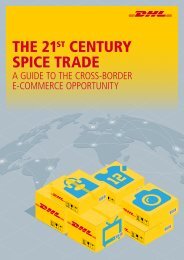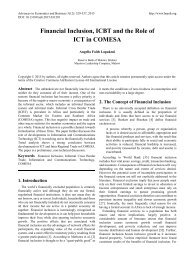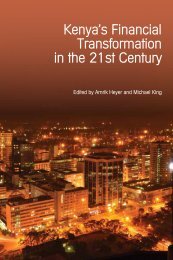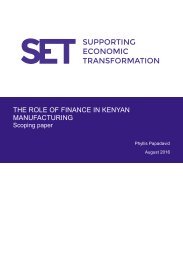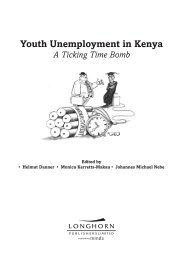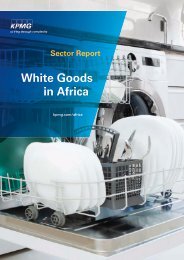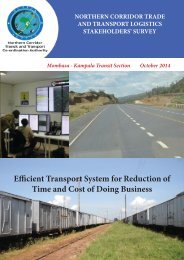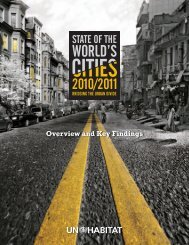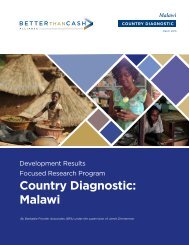FD
gvti301SEaf
gvti301SEaf
Create successful ePaper yourself
Turn your PDF publications into a flip-book with our unique Google optimized e-Paper software.
some cases, the attempts backfired. In Thailand, for example,<br />
market reaction to the imposition of an unremunerated reserve<br />
requirement on foreign inflows in December 2006 was swift and<br />
brutal: the stock market plunged 15 percent in less than a day,<br />
forcing the central bank to reverse the measure. The perception<br />
was that the measure had evoked memories of the currency<br />
crisis and imposition of outflow controls during the east Asian<br />
crisis about a decade earlier. Financial markets thus sent a clear<br />
signal that they did not approve of capital controls—on outflows<br />
or inflows—making little distinction between the two.<br />
Pure prejudice?<br />
So why do controls on capital inflows evoke such apprehension<br />
today? The historical record offers certain clues. First, dating<br />
at least to the interwar period, when the United States resisted<br />
imposing inflow controls, it appears that controls on capital<br />
inflows became inextricably linked with outflow controls. The<br />
latter were often associated with autocratic regimes, financial<br />
repression, and desperate measures to avoid crises in mismanaged<br />
economies. Thus, more liberal economies shunned the<br />
use of inflow controls as a short-term policy tool out of fear<br />
of being viewed as market unfriendly and institutionally weak.<br />
That inflow controls are damned by guilt by association<br />
with outflow controls is also evident in most of the other<br />
criticism levied against them, which is more pertinent to<br />
outflow controls. For instance, the fear that measures, once<br />
As emerging markets liberalized<br />
outflow controls, they also<br />
swept away many prudential<br />
inflow measures.<br />
imposed, will persist and become pervasive is generally true<br />
for outflow controls. Governments often resort to heavyhanded,<br />
broad-based measures to prevent capital flight, and<br />
these are difficult to remove because of pent-up demand.<br />
Inflow restrictions, by contrast, are typically taxes or higher<br />
reserve requirements, which are easy to reverse and generally<br />
are removed when the tide turns.<br />
Capital controls are also often criticized for being ineffective—but<br />
again that applies more to outflow controls, which<br />
have at best a weak track record when it comes to preventing a<br />
crisis (Edwards, 1999). There is, however, ample evidence that<br />
inflow controls shift the composition of capital flows toward<br />
less risky and longer-maturity liabilities (Ostry, Ghosh, and<br />
Qureshi, 2015), which strengthens the case for their use as<br />
prudential instruments.<br />
A second plausible reason is that capital account restrictions<br />
are often associated with current account restrictions.<br />
This is because, historically, the most common form of capital<br />
controls was exchange restrictions that impeded the movement<br />
of both goods and capital. As countries embraced greater trade<br />
liberalization, in contrast to the Keynes-White thesis, they<br />
started to view capital controls as incompatible with free trade<br />
rather than as aiding free trade. Capital account restrictions<br />
were thus abolished along with current account restrictions.<br />
This trend was further accentuated by the rise of regional trade<br />
agreements and bilateral investment treaties (especially those<br />
with the United States) that increasingly incorporated clauses<br />
prohibiting the adoption of capital controls.<br />
Finally, with the rise of free market ideology, which<br />
considers all government intervention inherently bad, capital<br />
controls—traditionally viewed as instruments to fine-tune<br />
the economy—became discredited more generally. Emerging<br />
market economies did not become entirely oblivious to the<br />
vagaries of capital flows, but they attempted to rely on more<br />
benign-sounding—also viewed as more market-friendly—<br />
“macroprudential measures” to tackle the risks to financial<br />
stability posed by capital inflows. Yet the effect on capital<br />
flows of some of these measures, especially those related to<br />
foreign currency transactions, is economically largely indistinguishable<br />
from that of more direct capital controls. If<br />
the intent is indeed to limit inflows for prudential reasons,<br />
then calling such measures macroprudential is merely a<br />
rebranding of capital controls, confirming that the negative<br />
connotation associated with the word “controls” is the real<br />
problem.<br />
Like any other policy instrument, capital controls on inflows<br />
have pros and cons—yet, in our view, they seem to be judged<br />
not so much on their merits as by pure prejudice that is rooted<br />
in history: damned largely because of their association with<br />
outflow controls but also because of ideological battles that<br />
have little to do with their specific use. Correcting unfounded<br />
perceptions is important to ensure that policymakers respond<br />
optimally to manage the risks associated with fickle capital<br />
flows and do not shy away from using measures simply<br />
because of the connotations of their name. ■<br />
Atish Rex Ghosh is IMF Historian and a Deputy Director<br />
in the IMF’s Strategy, Policy, and Review Department, and<br />
Mahvash Saeed Qureshi is a Senior Economist in the IMF’s<br />
Research Department.<br />
This article is based on the authors’ IMF Working Paper, No. 16/25,<br />
“What’s in a Name? That Which We Call Capital Controls.”<br />
References:<br />
Abdelal, Rawi, 2006, “Writing the Rules of Global Finance: France,<br />
Europe, and Capital Liberalization,” Review of International Political<br />
Economy, Vol. 13, No. 1, pp. 1–27.<br />
Edwards, Sebastian, 1999, “How Effective Are Capital Controls?”<br />
Journal of Economic Perspectives, Vol. 13, No. 4, pp. 65–84.<br />
Helleiner, Eric, 1994, States and the Re-emergence of International<br />
Finance: From Bretton Woods to the 1990s (Ithaca, New York: Cornell<br />
University Press).<br />
International Monetary Fund (IMF), 2012, “The Liberalization<br />
and Management of Capital Flows: An Institutional View,” IMF Policy<br />
Paper (Washington).<br />
Ostry, Jonathan, Atish Ghosh, and Mahvash Qureshi, 2015, Capital<br />
Controls (London: Edward Elgar).<br />
Finance & Development June 2016 51



